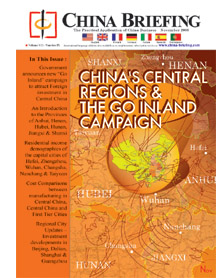Will the Anti-monopoly Law assist central regional development?
Additional M&A activity anticipated if China can banish SOE cartels
By Chris Devonshire-Ellis
SINGAPORE, Feb. 26 – Could China’s new anti-monopoly law, promulgated last August and coming into effect August, assist with paving the way for a resurgence of investment into China’s central and western regions? The new law also includes provisions for anti-monopoly policing, which often involves large enterprises and the government, and demands that anti-monopoly law enforcers possess sufficient independence and authority. While many commentators on China law only look at the immediate impact on foreign investors, the implications for FDI in China and the development of infrastructure elsewhere – of critical strategic importance to foreign investors has been ignored. Yet let us look at the implications here.
China’s domestic M&A activity over the past three years, which has increased from US$20 billion to US$80 billion in 2007, has largely been driven by the State. Essentially, the Chinese government has created a market situation whereby it’s own, diverse, unconnected and badly planned infrastructure problems are being realigned, via M&A activity, into better managed, interconnected entities with better management control, funded by both the domestic and international investor. It has to be this way. Just look back a couple of weeks to the government’s serious problems with the weather. China is no stranger to the cold, yet the heavier than normal snap threw the country’s infrastructure into chaos, especially in the power sector with entire cities of millions of people being without electricity for days. There are many who say that China’s infrastructure is great. It plainly isn’t – it’s creaky, inefficient, poorly connected, badly managed and under-funded. The government knows this – and as was reported yesterday – many of its larger M&A deals have indeed been to realign diverse energy businesses into one entity, as the Beijing government’s acquisition through Hong Kong of Beijing Gas aptly demonstrates.
So, what are we to make of the new anti-monopoly law? What is predictable are the groans of the foreign lawyers. What isn’t, and what hasn’t been heard are the true implications. So let’s just pause for a moment and reflect. Anti-monopoly law…China…inefficient SOEs…monopolistic practices…lack of competition…it sounds like the China we love to knock. Yet what are the major problems with getting development and FDI into the central regions? Exactly those same issues..
China has to develop its interior, it has no choice. Without unlocking the key to its heartland, and getting its rural population (about 50 percent of its total population) involved in the new wealth of the country, the Communist Party will just run out of steam. Revolutions have always begun in the countryside, and that is no way to develop a country. Getting more income into the central and western regions, a higher standard of education, goods flowing to and fro…this is the lock that China must pick to sustain its growth and prevent it from sliding backwards. Doing away with a few noisy and vociferous State-owned enterprises political bargaining to continue as de facto local monopolies will be a small price to pay for such a prize.
 Back in November 2006, we ran an issue of China Briefing entitled China’s Central Regions and the Go Inland Campaign. In it, we ran a piece on the cost of manufacturing for export in the six provinces identified by the State Council as being part of the “Go Inland Campaign”, being Anhui, Henan, Hubei, Hunan, Jiangxi and Shanxi, and their main cities of Changsha, Hefei, Nanchang, Taiyuan, Wuhan and Zhengzhou. We then compared these with the costs of manufacturing and exporting in the more expensive cities of Beijing / Tianjin, Shanghai, and Guangzhou in Guangdong province. In every single case, it was more expensive to manufacture and export via the inland city and region than the coastal one, despite the fact the land and labor costs were significantly cheaper. It cost more to export from Hefei, in Anhui, than it did from nearby Shanghai. It was even more expensive to manufacture in Anhui and attempt to export via Guangzhou. The same was true for other locations compared with their closest sea ports. The only feasible economic justification to manufacture inland is if you intend to sell on the domestic markets. For export, it’s economically unviable.
Back in November 2006, we ran an issue of China Briefing entitled China’s Central Regions and the Go Inland Campaign. In it, we ran a piece on the cost of manufacturing for export in the six provinces identified by the State Council as being part of the “Go Inland Campaign”, being Anhui, Henan, Hubei, Hunan, Jiangxi and Shanxi, and their main cities of Changsha, Hefei, Nanchang, Taiyuan, Wuhan and Zhengzhou. We then compared these with the costs of manufacturing and exporting in the more expensive cities of Beijing / Tianjin, Shanghai, and Guangzhou in Guangdong province. In every single case, it was more expensive to manufacture and export via the inland city and region than the coastal one, despite the fact the land and labor costs were significantly cheaper. It cost more to export from Hefei, in Anhui, than it did from nearby Shanghai. It was even more expensive to manufacture in Anhui and attempt to export via Guangzhou. The same was true for other locations compared with their closest sea ports. The only feasible economic justification to manufacture inland is if you intend to sell on the domestic markets. For export, it’s economically unviable.
And here is the rub. China’s national transportation network is badly connected, under-funded, and controlled by SOE cartels. The Ministry of Rail, for example, has roughly the same amount of track in China as the US has in the States, but is running at a capacity 5 times higher. It’s also highly expensive due to demand. The same is true of the Yangtze River network. Shipping goods from a manufacturing base say in Chongqing to Shanghai is eminently feasible. Except the two operators who are licensed to do so run appallingly bad services with no incentive to improve. Such problems remain the largest hurdle for the central government to overcome to finally shift focus into the central and western regions.
If the anti-monopoly law is given bite by State enforcement, it could just be the catalyst that China needs to break the iron grip of inefficiency in the national transportation systems and permit the nation, finally, to open up its heartland. The focus of the legislation may yet prove to be just that, and if so, foreign investors and merchant bankers should be doing their homework on the likely Chinese companies within these regions that stand to benefit most, instead of the current knee jerk reactions about protectionist measures being introduced to curb foreign investment interests. The real implications of the law are far more significant if one reads beyond the rhetoric.
Related
China M&A activity unlikely to slow down
China to introduce more M&A rules
Foreign investment will not be affected by new anti-monopoly laws
- Previous Article Joint ventures in China as commercial investment sense
- Next Article China Briefing’s new technical guide to China M&As published























